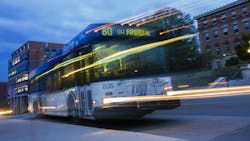Op-Ed: Let’s put the ‘T’ in transit - Why a simple endorsement change could open doors for bus drivers and strengthen service reliability
Public transit is the backbone of daily life. Buses carry millions of people to work, school, medical appointments and essential services. Yet, across the country, transit agencies are struggling to find and keep enough bus operators. Routes are being cut, riders are left waiting and agencies are stretched thin at the exact moment when reliable service matters most.
One possible reason is hiding in plain sight: the commercial driver’s license (CDL) requirements, especially the air brake endorsement. On paper, these rules promote safety and uniformity. In practice, they shut the door on people who are ready and willing to drive.
The hidden barrier of air brake testing
Modern bus air brake systems are federally regulated to be fail-safe. Drivers are alerted if pressure drops below 60 psi, and if it falls further, spring brakes automatically lock in to stop the bus. A bus can’t just lose its brakes; the system engages before that can happen.
Despite these safeguards, CDL applicants must pass a technical verbal exam covering compressors, chambers, slack adjusters and inspection procedures. That makes sense for long-haul truckers who may find themselves fixing rigs on the roadside. It doesn’t make sense for urban bus operators, whose vehicles are maintained daily by certified mechanics.
In effect, we’re screening applicants on their ability to memorize mechanical vocabulary, not on their ability to drive safely, respond to emergencies or interact with passengers.
Testing complexity and educational barriers
Ask any trainer, and they’ll tell you the CDL test trips up good candidates for the wrong reasons. Terms like “retarder,” “anti-lock braking system” and “brake fade” read like engineering textbooks. Even fluent English speakers stumble over the memorization.
The result? Too many capable applicants fail the written or verbal portions. Some quit before finishing. Others pass but walk away discouraged by a system that feels stacked against them, not by the realities of the job itself.
This is more than a testing quirk. It’s a workforce challenge. We’re losing skilled, motivated candidates because the licensing process emphasizes academic recall over real-world driving ability.
A practical solution: The “T” endorsement
There’s a straightforward fix. Create a “T” endorsement for public bus operators. Just as the “S” endorsement exists for school bus drivers, a T endorsement would tailor requirements to the transit role.
Here’s why it makes sense:
- Role-specific focus: Bus operators drive. Mechanics repair. Testing should reflect that.
- Strong training: Agencies already put operators through classroom sessions, road training and refreshers.
- Professional maintenance: Certified staff handle inspections and repairs, removing the burden from drivers.
- Built-in safety: Modern bus systems automatically engage brakes if pressure drops, keeping riders safe.
- Workforce stability: Reducing artificial barriers helps agencies recruit and retain operators, avoiding costly turnover.
- Clear accountability: Agencies are publicly funded, audited and regulated, placing responsibility squarely on management—not on individual drivers—for fleet state-of-good-repair.
- Indemnification safeguards: Public agencies already carry liability coverage and indemnify operators for equipment failures, ensuring drivers aren’t unfairly exposed for issues beyond their control.
To keep accountability tight, the T endorsement could apply only to transit agencies receiving federal funding, where oversight and reporting requirements already exist. That ensures public safety while preventing misuse by private carriers.
Safety is not compromised
Some will argue any exemption lowers standards. I see it the opposite way. Refocusing testing on safe driving, emergency response and passenger care would strengthen safety outcomes.
Memorizing mechanical terms doesn’t make someone a better operator. It just weeds out candidates who might otherwise excel in the driver’s seat. At a time when service is already fragile, that’s a cost we can’t afford.
The stakes for communities
Every unfilled operator position means another canceled trip, another late arrival, another frustrated rider. For people who rely on transit, that can mean missed shifts, missed appointments and fewer connections to opportunity.
Meanwhile, these are steady, good-paying and often union-protected jobs, the kind of careers that help families reach the middle class. The door should be open wider, not narrower.
An opinion worth considering
The CDL system, as it stands, creates more obstacles than outcomes for public bus operators. A T endorsement would align licensing with today’s realities, rigorous training, professional maintenance and buses built with safety systems that didn’t exist a generation ago.
Safe service depends on skilled drivers, not perfect test-takers. If we want to stabilize the workforce and strengthen service reliability, it’s time to ask whether the current system is measuring what really matters.
About the Author

Herold Humphrey
Senior Vice President, BDE Transportation - Americas, EFESO
Herold Humphrey is a senior transit executive and consultant with over 35 years of leadership experience driving operational excellence, workforce development and cost optimization across U.S. transit agencies.
